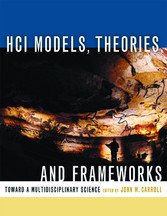Search and Find
Service
Cover
1
Copyright Page
7
Contents
8
Acknowledgments
18
Chapter 1. Introduction: Toward a Multidisciplinary Science of Human-Computer Interaction
20
1.1 The Golden Age
21
1.2 Let 100 Flowers Blossom
23
1.3 Scientific Fragmentation
24
1.4 Teaching and Learning
26
Chapter 2. Design as Applied Perception
30
2.1 Motivation
30
2.2 Scientific Foundation
31
2.3 Case Study
41
2.4 Current Status of Theoretical Approach
42
Chapter 3. Motor Behavior Models for Human-Computer Interaction
46
3.1 Motivation
46
3.2 Overview: Models and Modeling
46
3.3 Scientific Foundations and Model Descriptions
54
3.4 Case Studies
62
3.5 Current Status and Further Reading
72
Chapter 4. Information Processing and Skilled Behavior
74
4.1 Motivation for Using the Human Information Processing Theory in Human- Computer Interaction
74
4.2 Overview of GOMS
78
4.3 Scientific Foundations Underlying GOMS
81
4.4 Detailed Description of GOMS Models
91
4.5 Case Study: Project Ernestine
103
4.6 Current Status
116
4.7 Further Reading
119
Chapter 5. Notational Systems„The Cognitive Dimensions of Notations Framework
122
5.1 Motivation
122
5.2 Overview
125
5.3 Scientific Foundations
128
5.4 Detailed Description
131
5.5 Case Study: Evaluating a Visual-Programming Language
141
5.6 Current Status
147
5.7 Further Reading
152
Chapter 6. Users’ Mental Models: The Very Ideas
154
6.1 Motivation
154
6.2 Scientific Foundations
157
6.3 Detailed Description
165
6.4 Case Study
171
Chapter 7. Exploring and Finding Information
176
7.1 Introduction
176
7.2 Motivation: Man the Informavore
176
7.3 Scientific Foundations
180
7.4 Detailed Description: Scatter/Gather
187
7.5 Case Study: The World Wide Web
201
7.6 Current Status
209
Author Notes
210
Chapter 8. Distributed Cognition
212
8.1 Motivation
212
8.2 Overview
216
8.3 Scientific Foundations
217
8.4 Detailed Description
222
8.5 Case Study: Engineering Design and Construction
233
8.6 Current Status
241
Author Notes
242
Further Reading
242
Chapter 9. Cognitive Work Analysis
244
9.1 Motivation
244
9.2 Overview of CWA
248
9.3 Scientific Foundations
253
9.4 Detailed Description
258
9.5 Case Studies
271
9.6 Current Status
281
Further Reading
283
Chapter 10. Common Ground in Electronically Mediated Communication: Clark’s Theory of Language Use
284
10.1 Motivation
285
10.2 Overview
288
10.3 Scientific Foundations
292
10.4 Detailed Description
293
10.5 Case Studies„Applying the Theory to the Design of Technology for Communication
299
10.6 Current Status
307
10.7 Further Reading
308
Acknowledgments
308
Chapter 11. Activity Theory
310
11.1 Motivation
310
11.2 Overview
314
11.3 Scientific Foundations
317
11.4 Detailed Description
323
11.5 Case Study
335
11.6 Current Status
341
11.7 Further Reading
343
Chapter 12. Applying Social Psychological Theory to the Problems of Group Work
344
12.1 Motivation
344
12.2 An Overview of CSCW Research
346
12.3 Scientific Foundations
347
12.4 Detailed Description„Explaining Productivity Loss in Brainstorming Teams
362
12.5 Case Study: Applying Social Psychological Theory to the Problem of Undercontribution to Online Groups
367
12.6 Current Status
372
Chapter 13. Studies of Work in Human-Computer Interaction
376
13.1 Motivation
376
13.2 Overview: A Paradigmatic Case
378
13.3 Scientific Foundations
381
13.4 Detailed Description
388
13.5 Case Study
393
13.6 Current Status
398
13.7 Further Reading
399
Chapter 14. Upside-Down Vs and Algorithms.Computational Formalisms and Theory
400
14.1 Motivation
400
14.2 Overview of Issues and First Steps in Formalism
404
14.3 Scientific Foundations
408
14.4 Detailed Description
419
14.5 Case Study„Dialogue Speci.cation for Transaction Processing
432
14.6 Current Status
441
14.7 Further Reading
447
Chapter 15. Design Rationale as Theory
450
15.1 Motivation
451
15.2 Overview
453
15.3 Scientific Foundations
458
15.4 Detailed Description
463
15.5 Case Study
465
15.6 Current Status and Further Reading
479
Acknowledgments
480
Glossary
482
References
494
Index
540
About the Authors
566
All prices incl. VAT














